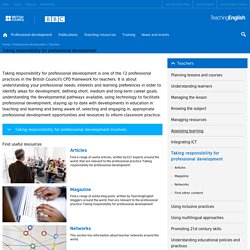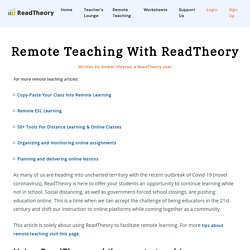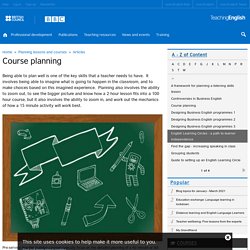

TeachingEnglish. Willy Cardoso: Classroom based teacher development. About the webinar Recorded in 2013, this webinar with Willy Cardoso looked at several aspects of classroom-based teacher development:

Action Research - Stop, Start, Continue. I get students to brainstorm all the kind of things I as a teacher do and things which we do in class. Some examples might be: speaking in pairsplaying gamesexplaining grammarsetting homework Once I have a list of the main areas, I give out a sheet of paper to each student and get them to draw three columns on the page. I then get them to write the words stop, start,and continue, one word at the top of each column.
Peer observation. In this article I shall look at the basic principles underlying peer observation and its value to institutions and to individual teachers. What is peer observation? Quality control or professional development? How should peer observation be organised? Reflective teaching: Exploring our own classroom practice. By collecting information about what goes on in our classroom, and by analysing and evaluating this information, we identify and explore our own practices and underlying beliefs. This may then lead to changes and improvements in our teaching. Reflective teaching is therefore a means of professional development which begins in our classroom. Why it is importantBeginning the process of reflection Teacher diary Peer observation Recording lessons Student feedback What to do next Think Talk Read Ask Conclusion. TeachingEnglish.
Skip to content Taking responsibility for professional development Taking responsibility for professional development is one of the 12 professional practices in the British Council's CPD framework for teachers.

Lessons and teaching 4.8 Virtual observation lesson plan. Lessons and teaching 4.7 Observation tasks. K-12 Education Tips & Strategies That Work. Zoom top tips. Site. Creativity in the English language classroom. TeachingEnglish. Lessons and teaching 3.7 Giving clear instructions. Lessons and teaching 3.6 Using L1 or not. TeachingEnglish. Realia. Here are a few suggestions for activities using realia and to consider why we may want to bring things into the class.

Why use realia in class? The main advantage of using real objects in the classroom is to make the learning experience more memorable for the learner. To give a couple of simple examples, if you are going to teach vocabulary of fruit and vegetables it can be much more affective for students if they can touch, smell and see the objects at the same time as hearing the new word. This would appeal to a wider range of learner styles than a simple flashcard picture of the fruit or vegetable. A second example would be if you are going to teach some functional language for asking for the timetable for a train. Here is a selection of activities involving realia. Tourist information Gather some city/town maps from the tourist information bureau wherever you are. ConcentrationSee these instructions on how to play this game:www.teachingenglish.org.uk/article/concentration Further reading.
Plenary session by Joy Egbert. About the session Engagement principles and practice in classroom learning, language and technology A still-common issue with technology use in language learning is an overly-strong focus on the digital tools and a relatively weak emphasis on actual learning.

This technocentric approach may arise, in part, from a lack of clear theoretical grounding for classroom technology use. While it's unclear whether atheoretical uses of technology actually provide barriers to learning, it is clear from the research that principled uses can lead to student achievement. TeachingEnglish. Lessons and teaching 2.11 Tips for using the board effectively. ESL Flashcards - Download free printable flashcards! Flashcard maker. Readtheory. For more remote teaching articles: As many of us are heading into uncharted territory with the recent outbreak of Covid-19 (novel coronavirus), ReadTheory is here to offer your students an opportunity to continue learning while not in school.

Social distancing, as well as government-forced school closings, are pushing education online. Home Page - ESL. Early Years Teaching Resources: Literacy and Numeracy Activities. English as a Second Language (ESL) for Teachers and Students. ESL Kids lesson plans, worksheets, flashcards, songs, readers, games. BusyTeacher.org. Writing a lesson plan will ensure that you are prepared for your class and will make it run more smoothly.

It is important to break the material up into several sections and choose activities suitable for each. Knowing approximately how much time an activity will take is important, but after the first lesson you may need to adjust things accordingly. It is best to be flexible seeing as different classes will respond to material differently. If at any point students struggle, you will have to dedicate more time to instruction or drilling before moving on to practice activities. For the purposes of this example let’s assume that an English class is forty-five minutes long. Does your own lesson plan look like this? 1Warm up A warm up activity can be used in a number of ways.
The idea behind a lesson plan is that another teacher could pick it up and successfully teach your class without further instructions. Not all lessons will be conducted the same. Course planning. Pre-service teacher training courses typically focus on the detailed planning of a 40 minute or 60 minute lesson and don’t focus attention on how to go about planning a much longer scheme of work.

This is also an important area to consider though, because most teachers are involved in teaching courses, which may typically last anywhere between 30 and 120 hours. The aim of this article is to share some of the conclusions of a recent project I was part of, with the hope that it might enable other teachers to plan a little faster too! Why do we plan our lessons? I think that most teachers plan lessons in order to feel more confident in the class itself. If we know what we’re trying to achieve in the lesson, we are freed up to spend more time with the learners rather than worrying about our next step. TeachingEnglish. TeachingEnglish. Katherine Bilsborough: Lesson plans – less is more.
You can travel without a list of course but you will avoid a few problems if you spend a bit of time planning – not a whole week though. That would be silly. A few minutes should be enough. Pre-empting problems will bring peace of mind and when it comes to teaching, this is a major defence against burnout and work stress. New teachers who have had training will have been evaluated and assessed on their lesson plans. They will spend hours preparing a 45-minute lesson. Lessons and teaching 1.15 Course plan. Animation Studios. Lessons and teaching 1.4 Lesson planning templates. LearnEnglish Kids. Free resources for teens to help improve your English. English Profile - Home. Onestopenglish: Number one for English language teachers.